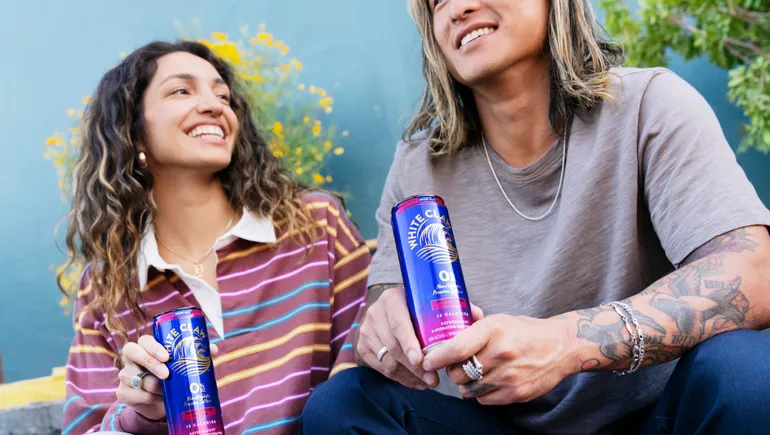Behind White Claw’s big nonalcoholic seltzer bet

White Claw knows its core consumer group is rethinking its relationship with alcohol, a shift that has prompted the hard seltzer pioneer to fight to get ahead before it’s too late.
The beverage maker’s biggest response came last month with the introduction of its first nonalcoholic offering, White Claw 0% Alcohol. The brand cited the growing number of young consumers, particularly Gen Z, who are abstaining or moderating their alcohol intake, as the genesis for the new drinks.
David Barnett, the chief commercial officer of White Claw’s parent company Mark Anthony Group, said in an interview the company is focusing on consumers over 21 who do drink alcohol but want to occasionally limit their consumption.
Consumer focus groups conducted by White Claw found a lack of interest in the available alcohol-free options, with 60% of those surveyed wanting something different than traditional sparkling water and nonalcoholic beer.
“People don’t want to get singled out when they’re out with friends and not participating — they don’t want to have to answer questions,” Barnett said. “They want to be part of the social occasion, connecting with friends.”
Despite being zero-proof, White Claw 0% will still exist within the alcohol distribution ecosystem and be shelved within the refrigerated drinks section at stores that sell liquor — next to other nonalcoholic options, like beer and mocktails. The new line comes in four flavors: Lime Yuzu, Peach Orange Blossom, Mango Passion Fruit and Black Cherry Cranberry.
To boost the health halo of the new product line, White Claw 0% Alcohol contains electrolytes for hydration. This addition came after White Claw found 72% of consumers it surveyed desired the ingredients in their nonalcoholic drinks.
The no and low-alcohol drinks space is a niche that is poised for further growth. The no and low-alcohol segment surpassed $11 billion in sales in 2022, and its sales are projected to increase at a compound annual growth rate of 9%, according to IWSR data.
White Claw believes its offerings allow a new group of consumers into the booze-free category by attracting fans of hard seltzer brand who don’t want the sugary additives of ready-to-drink mocktails.
“As companies like White Claw bring new, innovative products to the nonalcoholic beverages segments and really fulfill the need of what consumers want, I think the category will continue to expand and become more of a part of people’s everyday lifestyles,” Barnett said.

Optional Caption
Courtesy of White Claw
Staying on top of seltzer trends
White Claw burst onto the scene in the late 2010’s by appealing to college students and young consumers looking for a refreshing, canned hard beverage with a fruity taste.
A slew of imitators crowded the market, and the hard seltzer space saw several years of triple-digit growth. Giants in the alcohol space took notice of White Claw’s rapid ascent and debuted their own hard seltzer products, from Boston Beer’s Truly to AB InBev’s Bud Light Seltzer. None were able to topple White Claw from its perch.
While the category has seen a slowdown in recent years, White Claw remains on top, with a 60% share according to the brand. But it continues to face competition in alcohol from trendy offerings in the ready-to-drink space, such as hard soda and tea products. To offset the slowdown in hard seltzer, White Claw has expanded its alcoholic offerings through the launch of products such as Vodka + Soda.
Barnett said the company’s focus on the quality of its products is why it believes White Claw 0% will succeed.
“We have spent decades building proprietary technologies for the highest quality water and filtration techniques to produce ultra-refined seltzers,” Barnett said. “That’s why White Claw has been able to stay on top of the category as so many new innovations have come into hard seltzer.”
Source: fooddive.com

